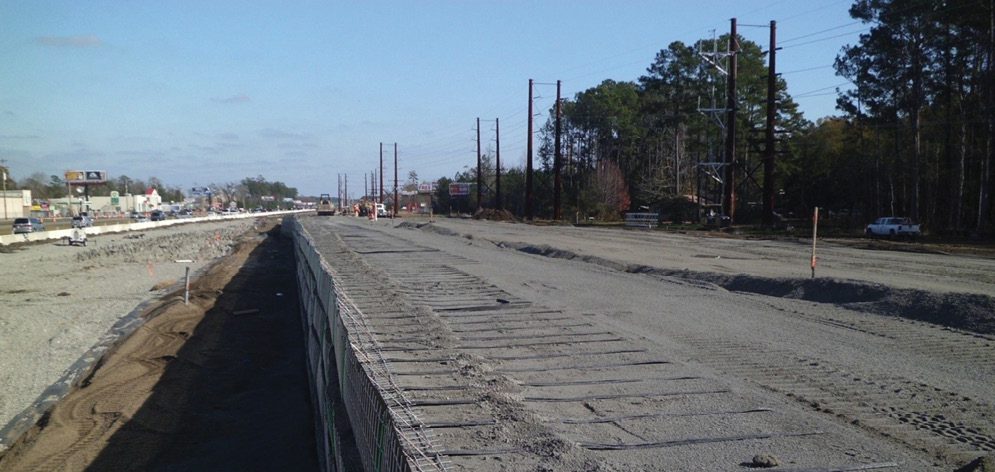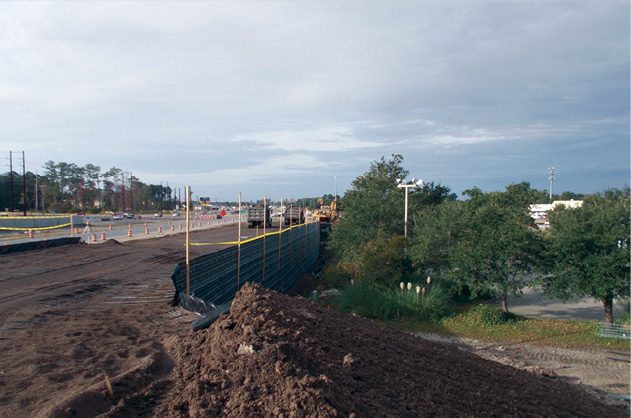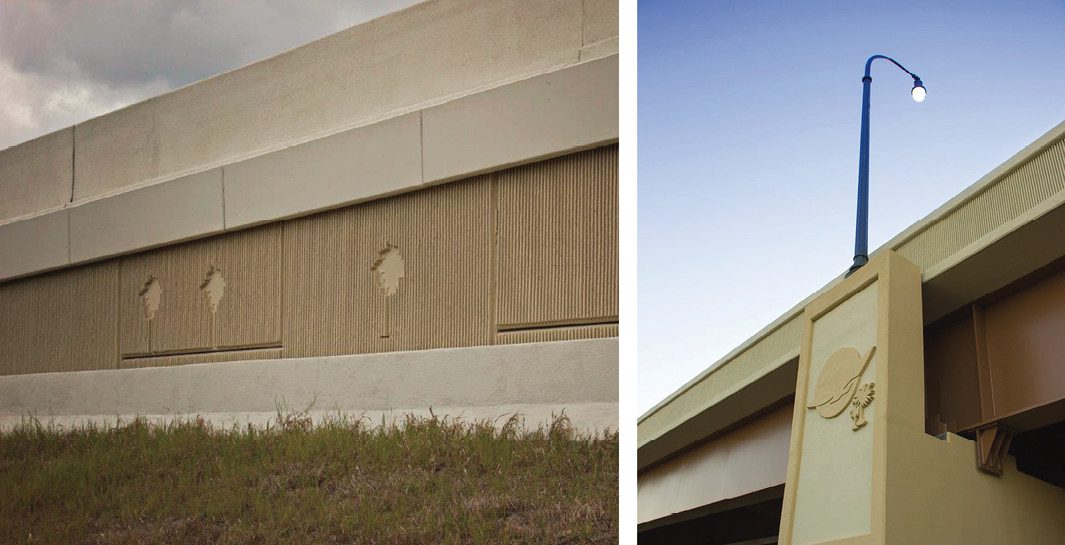Creating Certainty: Expanded Shale, Clay and Slate Aggregates Improve Seismic Design

Lightweight aggregate helps address seismic concerns on a highway project. (Acrosa Lightweight)
The ground a structure is built on plays an important role in what’s possible for that project—soil’s stability and relative depth to the bedrock can determine a structure’s height, footprint and weight limitations. It also can help a building better-resist seismic activity. The soil around a structure can change seismic waves’ frequency content and amplitude; these soil-structure interactions are known as “site effects.”
For example, seismic waves travel faster through hard rock than soft soil. When these waves transition from hard to soft soil layers, they travel slower and their amplitude increases, resulting in stronger shaking. The same principle applies to soil thickness between bedrock and the soil surface, since deeper soil layers translate to more soft material a seismic wave must travel through. This observation means two points at roughly equivalent distances from an earthquake’s epicenter may experience different aftermaths.
When modifying or improving soil conditions is necessary, engineers can use geotechnical fills that promote more-favorable site effects, enhance resistance to liquefaction, increase lateral stability, and boost shear strength and bearing resistance. Because expanded shale, clay and slate (ESCS) aggregates have a lower density and a predictably high internal angle of friction, they can help engineers improve a soil’s ability to provide robustness and reliability—therefore improving a structure’s seismic resilience. Due to this material’s high level of regularity, it also can help engineers more-closely approximate a soil’s static and dynamic loading conditions.
Soil-Structure Interaction During Seismic Events
According to the Federal Emergency Management Agency (FEMA), three linked systems affect a building’s response to seismic activity: the structure, the foundation, and the soil underlying and surrounding the foundation. As indicated in “Influence of soil properties on the seismic response of structures” (Bourouaiah, W., Khalfallah, S., and Boudaa, S.; 2019), research into the interaction among soil and structures concludes that behaviors of and damages incurred by concrete structures during earthquakes are highly affected by and largely dependent on soil properties. Although studies into this relationship are reasonably complex, the most-basic understanding of soil-structure interaction is that including soil in modeling processes can help engineers better understand the distribution of forces and displacements throughout a structure during a seismic event.
After exploring how soil type and depth can influence pile size and number; foundation depth, size and design; the implementation of soil springs and more; engineers can use this information to design more seismically resilient buildings. Although the best course of action for a project can vary significantly depending on location and structure type, starting with the soil can be a viable initial first step in designing with seismic resilience in mind.
For example, while structural engineers generally seek a common set of site characteristics (e.g., soil and rock features, geotechnical hazards that need to be mitigated, recommendations on appropriate foundation system, etc.), thinking of the soil as more influential and changeable can help these engineers design possible solutions to specific site problems. Further, looking to the soil as a starting point for seismic resilience will become increasingly important as the use of marginal sites becomes more prevalent for new construction. These sites often require ground modification due to poor, unsuitable, suspect or uncontrolled soils. By modifying these soils first, building professionals can reduce construction time and cost to reach the benchmark for seismic design requirements or improve seismic resilience beyond this baseline.
Field and Lab Tests That Determine Soil Stability
The behavior of soils under static and dynamic loading conditions can be a key factor in seismic design. Engineers often employ field and lab tests to determine a location’s soil behavior. While this approach provides a substantial level of certainty as to how soils will act during a seismic event, there’s still a margin of uncertainty.
For example, the standard penetration test (SPT) may be one of the most-frequently used field tests worldwide. It provides samples of relative densities of granular deposits. Simple and inexpensive, the SPT can be a valuable tool in determining soil behavior. It is, however, not without flaws. Weak soil types will not return accurate data for these tests. Further, using SPT data to predict liquefaction potential suffers from roughness.
The unconfined compression test (UCT) is a simple laboratory test that assesses the properties of rocks and fine-grained soils. It measures the strength and the stress-strain characteristics of the rock or soil. Like SPT, this test is simple and relatively inexpensive. But it’s not applicable to cohesionless or coarse-grained soils. In addition, there will be significant variations in the strengths of undisturbed and remolded samples—potentially limiting the accuracy of results if not taken into account.

The shear strength of lightweight aggregate improves seismic resilience. (Acrosa Lightweight)
Uncertainties in evaluating seismic hazards warrant resilient engineering solutions with adequate reliability and robustness. Because ESCS lightweight aggregates are highly regulated, they can provide another touchpoint to increase the accuracy of field and lab soil tests. Available laboratory and field data for ESCS as manufactured aggregates contribute to design reliability and minimize construction costs due to field uncertainties. The availability of ESCS also contributes to resourcefulness and rapid recovery of infrastructure systems after disasters.
How Do ESCS Aggregates Bolster Seismic Design?
ESCS lightweight aggregates are fired in a rotary kiln. During this process, an unconnected network of interior voids forms to reduce the material’s density and increase its internal friction angle and shear strength. After the fired aggregate has cooled, it’s crushed and filtered to ensure a highly regulated particle size. All these aspects contribute to improved and predictable seismic response.
First, the highly regulated nature of ESCS lightweight aggregate helps engineers create a more-consistent and predictable soil. While soil improvement often looks to enhance the mechanical and structural properties of the ground around a structure, consistency can offer a secondary benefit. Because the aggregate particles display a relatively low variability, they can help mitigate some of the uncertainty inherent in common field and laboratory tests. This advantage may increase the technical accuracy of the test and ensure the soil will react as predicted during a seismic event—as well as provide long-term structural stability.

A completed MSE wall features lightweight aggregate backfill to improve seismic “site effects.” (Acrosa Lightweight)
In addition to the material’s high degree of particle consistency, ESCS lightweight aggregates display a high degree of shear strength. Triaxial and direct shear testing shows internal friction angles between 40 and 46 degrees. When ESCS is tested in direct shear per ASTM, the internal friction angle is between 42 and 44 degrees—compared to 30 to 38 degrees for ordinary fills. The increased internal stability these numbers represent—and the free-drainage characteristics—allow ESCS geotechnical fills to resist liquefaction during earthquakes more readily than other fills because the material can withstand more-significant shear stresses and alleviates pore water pressure through drainage. Because ESCS aggregates are free draining, their frictional angle and degree of stability will remain largely unaffected by the introduction of moisture. The ESCS high angle of internal friction also is vital to improve energy damping during seismic events affecting piles, abutments and other geotechnical structures transferring loads to the superstructure.
ESCS lightweight aggregate is easily compacted using standard and often lighter equipment for ground improvement in seismic design, contributing to accelerated construction and rapid recovery. This benefit helps create dilative soil and improves seismic resilience by increasing resistance to liquefaction, slides and similar hazards.
Building Resilience From the Ground Up
Although soil is only one part of constructing a highly resilient structure, its properties can affect the design possibilities for an entire project. Soils that work with foundations, piles and other structural support systems can either help a project reach minimal seismic resistance standards more efficiently or vastly improve the resilience of an entire building.
Using ESCS lightweight aggregates for ground improvement can bolster a project’s initial ability to resist earthquake damage and reduce foundation material needs. It can make sites with previously unfit or suspect soil more amenable to development. As such, when a project incorporates ground improvement for seismic considerations, ESCS aggregates can be a viable option for a geotechnical fill. 
About Jack Moore
Jack Moore, P.E., is the southern region marketing and technical manager for Arcosa Lightweight, with more than 30 years of experience in construction products and geosynthetic sales with a geotechnical engineering market focus; email: [email protected].


